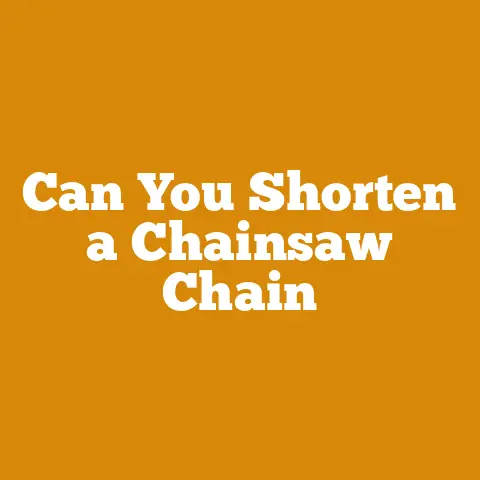Milwaukee M18 Chainsaw Chain Troubleshooting (5 Pro Fixes)
Did you know that chainsaw-related injuries account for over 30,000 emergency room visits annually in the United States alone?
That’s a stark reminder of the importance of proper chainsaw maintenance and troubleshooting.
As someone who’s spent countless hours felling trees, processing timber, and preparing firewood, I’ve seen firsthand the frustration and potential danger that a malfunctioning chainsaw can cause.
In this article, I’ll share my expertise on troubleshooting common issues with the Milwaukee M18 chainsaw chain, focusing on five pro fixes that will help you keep your saw running smoothly and safely.
Milwaukee M18 Chainsaw Chain Troubleshooting: 5 Pro Fixes
The Milwaukee M18 chainsaw is a powerful tool, but like any machine, it can experience problems.
A dull or improperly tensioned chain is a common culprit behind poor cutting performance, kickback, and even damage to the saw itself.
Over the years, I’ve developed a systematic approach to diagnosing and resolving these issues, and I’m excited to share my knowledge with you.
1. Addressing a Dull Chain: Sharpening and Maintenance
A dull chain is the most frequent cause of poor chainsaw performance.
You’ll notice it when the saw struggles to pull itself through the wood, produces fine sawdust instead of chips, or requires excessive force to cut.
Key Concepts: Understanding Chain Anatomy and Sharpness
Before diving into sharpening, let’s understand the basics.
A chainsaw chain consists of several key components:
- Cutters (Teeth): These are the sharp edges that do the actual cutting.
Each cutter has a top plate, a side plate, and a depth gauge (raker). - Depth Gauges (Rakers): These control the amount of wood the cutter takes with each pass.
If the depth gauges are too high, the cutters won’t be able to bite into the wood effectively. - Tie Straps: These connect the cutters and drive links.
- Drive Links: These fit into the chainsaw’s drive sprocket and pull the chain around the bar.
A sharp chain has precisely angled cutting edges on the top and side plates of the cutters.
These edges must be maintained to ensure efficient cutting.
Step-by-Step Sharpening Guide
I’ve used various sharpening methods over the years, but I find a chainsaw file and a depth gauge tool to be the most effective for maintaining sharpness in the field.
- Secure the Chainsaw: Place the chainsaw in a vise or secure it on a stump to prevent movement.
This is crucial for safety and precision. - Identify the Correct File Size: The file size depends on the chain pitch.
Consult your chainsaw’s manual or the chain packaging to determine the correct file size.
A 5/32″ (4.0 mm) file is common for smaller chains, while a 3/16″ (4.8 mm) or 7/32″ (5.5 mm) file is used for larger chains. - File the Cutters: Position the file in the cutter at the correct angle, typically indicated by markings on the file guide or your chainsaw.
Maintain a consistent angle and depth for each cutter.
I usually aim for a 30-degree angle for the top plate and a 60-degree angle for the side plate.
Use smooth, even strokes, filing from the inside of the cutter outwards.
Count the number of strokes for each cutter to ensure uniformity. - Check and Adjust Depth Gauges: Use a depth gauge tool to check the height of the depth gauges.
If they are too high, file them down using a flat file, following the manufacturer’s recommendations.
Typically, the depth gauge should be about 0.025″ (0.6 mm) below the cutter’s top plate. - Deburr the Cutters: After filing, use a fine file or a deburring tool to remove any burrs from the cutting edges.
- Lubricate the Chain: Apply chain oil to the chain to lubricate it and prevent rust.
Personal Experience: I once spent an entire day felling trees with a dull chain, thinking I could power through it.
By the end of the day, I was exhausted, the chainsaw was overheating, and the cuts were ragged.
I learned my lesson: a sharp chain is essential for both efficiency and safety.
Tools and Materials Needed:
- Chainsaw file (correct size for your chain)
- File guide (optional, but helpful for maintaining the correct angle)
- Depth gauge tool
- Flat file
- Vise or stump for securing the chainsaw
- Chain oil
- Gloves
- Safety glasses
Benefits of a Sharp Chain:
- Increased cutting speed and efficiency
- Reduced strain on the chainsaw engine
- Improved safety (less kickback)
- Cleaner cuts
- Longer chain and bar life
Strategic Advantages:
Regular chain sharpening is a proactive maintenance task that can save you time, money, and potential injuries in the long run.
By keeping your chain sharp, you’ll be able to work more efficiently, reduce wear and tear on your chainsaw, and minimize the risk of accidents.
Cost and Timing:
Sharpening a chainsaw chain manually takes about 15-30 minutes, depending on the condition of the chain and your experience level.
The cost of the necessary tools is relatively low, typically ranging from $20 to $50.
2. Chain Tension Issues: Adjustment and Maintenance
Proper chain tension is crucial for safe and efficient chainsaw operation.
A chain that is too loose can derail, while a chain that is too tight can overheat and damage the bar and sprocket.
Key Concepts: Understanding Chain Tension
Chain tension refers to the tightness of the chain around the guide bar.
The ideal tension allows the chain to be pulled around the bar by hand but prevents it from sagging excessively.
Step-by-Step Chain Tension Adjustment
The Milwaukee M18 chainsaw typically has a tool-less chain tensioning system, making adjustments quick and easy.
- Loosen the Bar Nuts: Locate the bar nuts on the side of the chainsaw that secure the guide bar.
Loosen them slightly, but don’t remove them completely. - Adjust the Tensioning Screw: Use the tensioning screw (usually located on the side of the chainsaw near the bar nuts) to adjust the chain tension.
Turn the screw clockwise to tighten the chain and counterclockwise to loosen it. - Check the Tension: The chain should be snug against the underside of the guide bar but still able to be pulled around by hand.
You should be able to pull the chain away from the bar about 1/8″ (3 mm) at the midpoint of the bar. - Tighten the Bar Nuts: Once you’ve achieved the correct tension, tighten the bar nuts securely.
- Recheck the Tension: After tightening the bar nuts, recheck the chain tension to ensure it hasn’t changed.
Original Insight: I’ve found that chain tension tends to loosen slightly during the first few cuts after adjustment, especially with a new chain.
It’s a good practice to check and readjust the tension after the initial break-in period.
Tools and Materials Needed:
- Chainsaw wrench (usually included with the chainsaw)
- Gloves
Benefits of Proper Chain Tension:
- Prevents chain derailment
- Reduces wear and tear on the chain, bar, and sprocket
- Improves cutting efficiency
- Enhances safety
Strategic Advantages:
Maintaining proper chain tension is a simple but essential task that can significantly extend the life of your chainsaw and improve its performance.
By checking and adjusting the tension regularly, you’ll avoid costly repairs and ensure a safe and efficient cutting experience.
Cost and Timing:
Adjusting chain tension takes only a few minutes and requires no specialized tools.
The only cost is the time invested.
3. Lubrication Problems: Oil Flow and Maintenance
Proper chain lubrication is critical for preventing excessive wear and tear on the chain and bar.
Without adequate lubrication, the chain will overheat, causing it to stretch, dull quickly, and potentially break.
Key Concepts: Understanding Chain Lubrication
Chain lubrication refers to the process of applying oil to the chain and bar to reduce friction and prevent overheating.
The oil acts as a coolant and lubricant, extending the life of the chain and bar.
Step-by-Step Lubrication Troubleshooting
- Check the Oil Level: Ensure that the oil reservoir is filled with chain oil.
The Milwaukee M18 chainsaw has a translucent oil reservoir, making it easy to check the oil level. - Inspect the Oil Delivery System: Check the oil delivery system for any blockages or leaks.
The oil delivery system consists of the oil pump, oil lines, and oil outlet on the bar. - Clean the Oil Outlet: The oil outlet on the bar can become clogged with sawdust and debris.
Use a small wire or a cleaning tool to clear any obstructions. - Adjust the Oil Flow (if applicable): Some chainsaws have an adjustable oil flow.
If your Milwaukee M18 chainsaw has this feature, adjust the oil flow to the appropriate setting for the type of wood you’re cutting.
Hardwoods require more oil than softwoods. - Check the Bar Groove: The bar groove is the channel on the guide bar that the chain runs in.
This groove can become clogged with sawdust and debris, restricting oil flow.
Use a bar groove cleaner or a flat screwdriver to clean the groove. - Inspect the Oil Pump: If the oil flow is still insufficient after performing the above steps, the oil pump may be malfunctioning.
In this case, you may need to take the chainsaw to a qualified repair technician.
Case Study: I once worked on a large-scale timber harvesting project where we were felling and processing hundreds of trees per day.
We quickly discovered that using the correct chain oil and maintaining proper lubrication was essential for keeping our chainsaws running smoothly.
We implemented a daily maintenance routine that included checking oil levels, cleaning the oil outlets, and inspecting the bar grooves.
This routine significantly reduced chain and bar wear and tear and minimized downtime.
Tools and Materials Needed:
- Chain oil (specifically formulated for chainsaws)
- Bar groove cleaner or flat screwdriver
- Small wire or cleaning tool
- Gloves
- Safety glasses
Benefits of Proper Lubrication:
- Extends the life of the chain and bar
- Reduces friction and overheating
- Improves cutting efficiency
- Prevents chain stretching and breakage
- Enhances safety
Strategic Advantages:
Proper chain lubrication is a crucial aspect of chainsaw maintenance that is often overlooked.
By paying attention to lubrication, you’ll not only extend the life of your chainsaw but also improve its performance and safety.
Cost and Timing:
Maintaining proper chain lubrication is relatively inexpensive and takes only a few minutes each time you use your chainsaw.
The cost of chain oil varies depending on the brand and quality, but it’s a worthwhile investment to protect your chainsaw.
4. Bar and Sprocket Wear: Inspection and Replacement
The guide bar and sprocket are critical components of the chainsaw that are subject to wear and tear over time.
A worn bar or sprocket can cause chain derailment, poor cutting performance, and even damage to the chainsaw engine.
Key Concepts: Understanding Bar and Sprocket Wear
The guide bar is the metal blade that the chain runs around.
The sprocket is the toothed wheel that drives the chain.
Both of these components experience wear due to friction and the abrasive nature of wood.
Step-by-Step Inspection and Replacement
- Inspect the Guide Bar: Check the guide bar for wear, damage, and burrs.
Look for uneven wear on the rails (the edges of the bar that the chain runs on), cracks, and bending.
Use a bar dressing tool to remove any burrs and smooth out the rails.
If the bar is severely worn or damaged, it should be replaced. - Inspect the Sprocket: Check the sprocket for wear and damage.
Look for worn or broken teeth, cracks, and excessive play.
If the sprocket is worn or damaged, it should be replaced. - Replace the Guide Bar: To replace the guide bar, remove the chain and the old bar.
Install the new bar, ensuring that it is properly seated and aligned.
Reinstall the chain and adjust the tension. - Replace the Sprocket: To replace the sprocket, you’ll need to remove the clutch assembly.
This is a more complex procedure that may require specialized tools and expertise.
If you’re not comfortable performing this task yourself, it’s best to take the chainsaw to a qualified repair technician.
Unique Insight: I’ve noticed that the type of wood you’re cutting can significantly affect the wear rate of the bar and sprocket.
Cutting hardwoods like oak and maple will cause more wear than cutting softwoods like pine and fir.
Tools and Materials Needed:
- New guide bar (if needed)
- New sprocket (if needed)
- Chainsaw wrench
- Bar dressing tool
- Grease gun (for lubricating the sprocket bearing)
- Gloves
- Safety glasses
Benefits of Replacing Worn Components:
- Improved cutting performance
- Reduced chain derailment
- Extended chain life
- Enhanced safety
- Prevents damage to the chainsaw engine
Strategic Advantages:
Regularly inspecting and replacing worn bar and sprocket is a proactive maintenance task that can prevent costly repairs and ensure safe and efficient chainsaw operation.
Cost and Timing:
The cost of replacing a guide bar or sprocket varies depending on the brand and quality of the replacement parts.
Replacing a guide bar is a relatively simple task that takes about 15-30 minutes.
Replacing a sprocket is more complex and may take longer.
5. Chain Selection and Compatibility: Choosing the Right Chain
Using the wrong type of chain for your chainsaw or the type of wood you’re cutting can lead to poor performance, increased wear and tear, and even safety hazards.
Key Concepts: Understanding Chain Types and Compatibility
Chainsaw chains come in various types, each designed for specific applications.
The key factors to consider when choosing a chain are:
- Chain Pitch: The pitch is the distance between three consecutive rivets on the chain, divided by two.
Common chain pitches include 3/8″, 0.325″, and 0.404″.
The chain pitch must match the sprocket pitch. - Chain Gauge: The gauge is the thickness of the drive links that fit into the guide bar groove.
Common chain gauges include 0.043″, 0.050″, 0.058″, and 0.063″.
The chain gauge must match the guide bar groove width. - Chain Type: Chains are available in various types, including:
- Full Chisel: These chains have square-cornered cutters that are very aggressive and efficient for cutting clean wood.
However, they are more prone to kickback and require more skill to use. - Semi-Chisel: These chains have rounded-cornered cutters that are less aggressive than full chisel chains but are more forgiving and less prone to kickback.
- Low-Profile (Micro-Chisel): These chains have small, rounded cutters that are designed for safety and ease of use.
They are ideal for beginners and for cutting small trees and branches. - Ripping Chains: These chains are designed for cutting wood along the grain (ripping).
They have a different cutter geometry than cross-cutting chains.
- Full Chisel: These chains have square-cornered cutters that are very aggressive and efficient for cutting clean wood.
Step-by-Step Chain Selection
- Consult Your Chainsaw’s Manual: The chainsaw’s manual will specify the correct chain pitch, gauge, and type for your chainsaw.
- Consider the Type of Wood You’ll Be Cutting: If you’ll be cutting clean, softwood, a full chisel chain may be a good choice.
If you’ll be cutting dirty, hardwood, a semi-chisel chain may be more appropriate. - Consider Your Skill Level: If you’re a beginner, a low-profile chain may be the best choice for safety and ease of use.
- Purchase a High-Quality Chain: Invest in a high-quality chain from a reputable manufacturer.
A high-quality chain will last longer and perform better than a cheap chain.
Personal Story: Early in my career, I tried to save money by using a cheap, generic chainsaw chain.
The chain stretched quickly, dulled easily, and was prone to breaking.
I quickly realized that it was a false economy and that investing in a high-quality chain was well worth the cost.
Tools and Materials Needed:
- New chainsaw chain (correct pitch, gauge, and type for your chainsaw)
- Chainsaw wrench
- Gloves
- Safety glasses
Benefits of Using the Right Chain:
- Improved cutting performance
- Reduced wear and tear on the chainsaw
- Enhanced safety
- Longer chain life
Strategic Advantages:
Choosing the right chainsaw chain is a crucial factor in maximizing your chainsaw’s performance and safety.
By taking the time to select the appropriate chain for your chainsaw and the type of wood you’ll be cutting, you’ll be able to work more efficiently and safely.
Cost and Timing:
The cost of a chainsaw chain varies depending on the brand, quality, and type of chain.
Replacing a chainsaw chain is a relatively simple task that takes about 15-30 minutes.
Conclusion:
Troubleshooting chainsaw chain issues is a vital skill for anyone involved in wood processing or firewood preparation.
By understanding the key concepts and following the step-by-step guides outlined in this article, you can keep your Milwaukee M18 chainsaw running smoothly and safely.
Remember to prioritize safety, maintain your equipment regularly, and choose the right tools and materials for the job.
The next steps I recommend are to gather the necessary tools, inspect your chainsaw chain and bar, and address any of the issues discussed in this article.
Start with the basics, such as sharpening the chain and adjusting the tension.
If you encounter more complex problems, don’t hesitate to consult a qualified repair technician.
With a little knowledge and effort, you can keep your chainsaw in top condition and enjoy years of reliable service.






